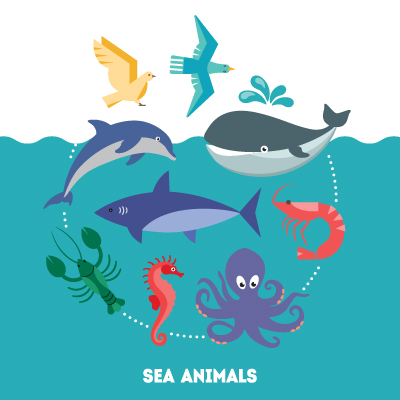Classification of Ecosystem and The Concept of Food Chain
What is an Ecosystem?
Imagine a bubble where the living and non-living co-exist and work together to get things going. Essentially, an ecosystem is an area where plants, organisms, animals, and other abiotic or non-living things thrive in a landscape under the influence of weather, temperature, and humidity.
Interdependency is an important factor that enables the ecosystem to function and continue its perpetuity by benefiting all the inhabitants. In a scenario where the temperature in the ecosystem changes, it directly has an impact on the plants, and when plants are adversely affected, animals depending upon plants for food and shelter are in-turn influenced negatively or positively. The only option to thrive in an ecosystem is to continuously adapt to the changes or move to another ecosystem, instead of perishing.
Types of Ecosystems
An ecosystem is based on the type of region, especially land or water. Majorly it can be classified as;
- Terrestrial Ecosystem
- Aquatic Ecosystem
Terrestrial Ecosystem –
Forest: Almost 1/3rd of Earth’s surface is covered in forests and they flourish under different weather conditions such as; dry, wet, and cold. This terrestrial ecosystem includes deciduous forests, plantation forests, and tropical rain forests, as they are home to different birds, animals, and other diverse species of plants and animals.
Grasslands: Grasslands occur where there is not too much rainfall to culminate a forest, but neither too scanty a rainfall that it becomes a desert. So, it is somewhat in-between a desert and a forest. Grasslands are covered with shrub-like vegetation and are found all across the world. Many types of wild animals such as; lions, zebras, elephants, etc. are found in grasslands.
Tundra: Cold regions of the Arctic and other high-altitude mountainous areas feature the tundra ranges. Tundra has large patches of bare grasslands with rocks and low vegetation such as moss, lichens, herbs, and shrubs. The surface is mostly covered in snow all through the year.
Desert: A desert, as we know it, is a region that has very scanty vegetation. The temperature in the desert area can be either extremely hot or extremely cold, or hot during the day and chilly at night, thereby making it unfavorable for vegetation to thrive. The most common desert plants that survive in these harsh conditions include; cactus, acacia, and date palm. Reptiles such as snakes and lizards are usually found in deserts.


Aquatic Ecosystem –
This includes water bodies such as; lakes, oceans, seas, rivers, which are home to amphibians, fish, sea creatures, and aquatic plants. Since 71% of the Earth’s surface is covered with water, the aquatic ecosystem is larger than the terrestrial ecosystem. An aquatic ecosystem is further classified into two categories namely; marine ecosystem and freshwater ecosystem. The marine ecosystem includes oceans and seas where sharks, seals, walrus, and other sea creatures thrive. The freshwater ecosystem is made up of rivers, lakes, ponds, and water bodies that are fresh or non-salted. The most common freshwater fish are; rohu, prawn, hilsa, and Indian carp, amongst others.
The Food Chain
A food chain is nothing but the transfer of energy in the form of food from one organism to the other. Green plants are capable of producing their own food with the help of photosynthesis. Hence, plants are classified as producers in the food chain. Humans and animals have to depend upon plants and other animals for their food, and hence this area is categorized as consumers. Decomposers such as fungi, bacteria, insects, break down the waste products and tissues of plants & animals which are absorbed in the soil and serve as nutrition to the plants. Hence the food chain is basically the unison between producers, consumers, and decomposers, providing nutrients to each other. The Food Chain can be further classified into three categories; grazing food chain, saprophytic or detritus food chain, and parasitic food chain.

What Students will learn with Carolina’s Building Blocks of Science® 3D: Life in Ecosystems (©2019) 1 Literacy set:
- Students make models discover that organisms have unique and diverse life cycles, but what’s common amongst them is birth, growth, reproduction, and death.
- Analyze data to find evidence that plants and animals have traits inherited from their parents and some variation of traits exists in a group of similar organisms.
- Experiment and support evidence that traits can be influenced by the environment.
- Analyze and interpret data from fossils to trace their existence long ago.
- Find out why in a given habitat some organisms can survive well, others struggle to survive, and yet others perish.
Carolina has specially designed this kit for Grade 3 students and offers 5 lessons across 15 class sessions under the Building Blocks of Science® 3D unit Life in Ecosystems kit. Schools that follow the k-12 curriculum and IB culture benefit manifold from the kit and most institutes in GCC Countries in the Middle East avail the lab kits for students to practice hands-on lessons. The unit includes the following – a teacher’s guide, on-grade student readers, access to online digital resources, apparatus, and lab supplies sufficient for a class of 30 students, amongst other support materials.
To learn more about other such interesting Building Blocks of Science® 3D unit kits by Carolina for those in the UAE, including Dubai, head to our website.






Recent Comments